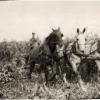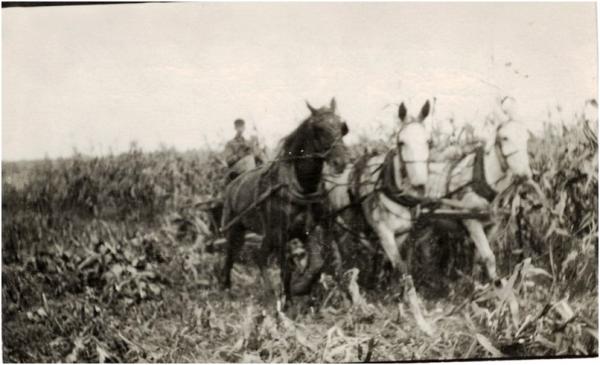Farming Changes from the 1800s to 1900s
| Grade | 4th Grade | Class | Social Studies | Length of Lesson | 1 Hour |
| Lesson Title | Farming Changes from the 1800s to 1900s |
| Unit Title | Agriculture Changes in the Midwest |
| Unit Compelling Question | What changes have occurred in agriculture since the 1800s in the Midwest? |
| Historical Context: Farming in the 1800s was not easy. Much of the plowing and planting work was done by hand, or with the help of a horse, mule, or ox. Early agricultural tools were wood, cast iron, hand held, and poorly crafted, resulting in many injuries. In the first half of the 1800s John Deere invented a polished steel plowshare that could break soil more easily than earlier cast iron implements. The polished plow allowed the sticky soil to slide off the steel, and farmers to work more quickly as they did not have to stop to clean off their plow as they did previously. Utilizing this plowshare behind a horse or mule eased the farmers work to a degree. With horse-drawn agricultural tools farmers could plant increasingly larger areas. By the late 1880s, steam engines were helping farmers with threshing, although the machinery was bulky and posed significant fire and injury threats. Shortly before the end of the century, John Froelich invented the first successful gasoline-powered engine that could be driven backwards and forwards. His design became the basis for the Waterloo Boy Tractor, which in time grew to be the John Deere tractor company. Between 1910 and 1960 tractor sales increased rapidly and replaced horses and mules in plowing, soil preparation, planting and cultivating, as well as mowing hay, harvesting wheat and small grains (combining), and later in cotton and corn picking. ~Allyson Simpson, Simpson College 2018.017.011 This photograph shows a Chickasaw County farmer cutting corn. The farmer appears to be using a corn cutter, which was a horse-drawn sled with blades attached to it that cut one or two rows of corn at a time. |
|
| Lesson Supporting Question | |
| Lesson Overview | Students will read and complete Venn Diagrams to compare farming practices, farming equipment and the life of farm families during 2 different time periods. They will also incorporate their current knowledge of farming in their area to begin to make connections and comparisons of earlier farming practices, to farming practices of today. They will look at how crops were planted and harvested and the tools used for that process, as well as examining the evolution of farming equipment. Students will also learn about “farm life” and the way farm families lived during the 1800s and 1900s. Again, they will compare the two different times and begin to make connections to the 1900s and today. |
| Primary Sources Used |
|
| Resources Needed | |
| Standard | |
| Lesson Target | Students will examine the differences in farming techniques, farming equipment, and farm families/life. |
| Lesson Themes | |
|
| Formative Assessment (How will you use the formative assessments to monitor and inform instruction?) |
For this lesson of the unit the formative assessment will be the Venn Diagram. Students will be required to write one characteristic they learned from today’s lesson about farming in the 1800s and 1900s. The information that is used in this Venn Diagram will be used to open the next lesson and re-open the discussion about the changes in agriculture over time. |
| Summative Assessment (How does the lesson connect to planned summative assessment(s)?) |
The entire unit the summative assessment will be a comparative essay. Students will be asked to write an essay through the perspective of farm families, from each time period (1800s, 1900s, today). They will be asked to describe what tools are being used and the difficulty of the work. It does not need to be any longer than a page, but they must discuss the tools, the work intensity and the living conditions. |
| Author | Megan Oliver | Created | Last Edited | ||||
| Reviewer: Dr. Chad Timm, Simpson College | |||||||
| Lesson Plan Development Notes: Social Studies Methods, Simpson College, Spring 2019 | |||||||


